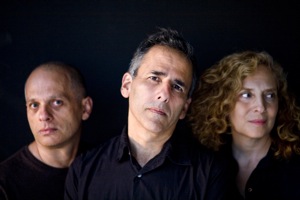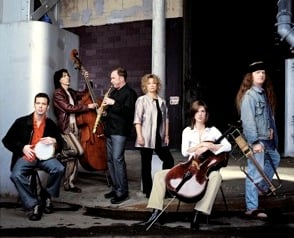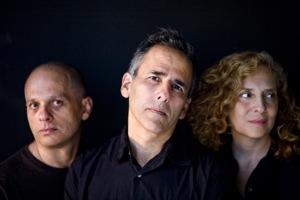It’s been nearly a quarter century since three composers just out of Yale moved to New York, got to be friends, bitched often about the city’s fragmented music scene and lack of opportunities to play and hear the kind of music they wanted to create — and then decided to do something about it.

Feeling excluded from establishment classical music institutions that then often shunned the rock, minimalist and pop culture influences they embraced, Julia Wolfe, Michael Gordon, and David Lang decided to throw a one-day festival of new music whose only common characteristic was its appeal to their own diverse tastes. Enlisting more than a score of other composers, they followed the examples of John Cage in the 1940s and Steve Reich and Philip Glass in the 1970s and chose an art gallery as the venue. On Mother’s Day in 1987, some 400 listeners (including almost all the composers) crammed into the SoHo space to hear the first Bang on a Can marathon — 12 hours of a wild assortment of sounds, including the ostensibly opposed aesthetics of arch-modernist Milton Babbitt and minimalist Reich, both in attendance, who refused to hear each other’s music. The audience cheered both.
Bang on a Can’s initial vision was to create a space for adventurous, uncategorizable, innovative music that was marginalized or excluded from New York’s — and America’s — balkanized aggregation of isolated scenes. “We built this festival,” Wolfe told the e-zine NewMusicBox in 1999, “to make a declaration about our idea about the lack of stylistic approaches, but also to make a new home for a whole new generation of composers.”
The Bang on a Can festival has since blossomed into an annual, much anticipated marathon that’s become America’s most valuable wellspring of contemporary music, even cracking the establishment bastions of Lincoln Center and Carnegie Hall, and featuring everything from rock bands to gamelans to koto orchestras to hip-hoppers to bagpipe ensembles. Its 20th-anniversary marathon at the World Financial Center drew some 6,000 listeners and stretched to 27 hours. The only real criterion for the music the three founders choose from the hundreds of recordings submitted for consideration each year: whether they all like the music.
“We like the people who live in between rooms,” Lang explained to NewMusicBox, “the people who are lodged in the wall between pop and classical music, or in the stairway between DJs and jazz. ... If you want a composer who’s really trying to do something interesting, you’re not trying to fit into a bin that has an easy location.”
Break Out: Connecting the Dots in the New-Music Scene
Listen to the Music
David Lang: Sunray
Louis Andriessen: Workers Union
In contrast to the decay infesting much of the classical music ecosystem, Bang on a Can has created a vibrant, flourishing community that writes and performs new music. It has produced hundreds of performances around the nation and abroad, sponsoring a vital commissioning fund, spawning a record label (Cantaloupe), hosting a summer institute for young composers and performers at the Massachusetts Museum of Contemporary Art (MASS MoCA), and spinning off a touring and recording ensemble of new-music virtuosos, the Bang on a Can All Stars, who have included some of today’s — and tomorrow’s — most visionary musicians, including a few “classical” instruments but also percussion and electric guitar.
The All Stars’ current incarnation alights in the Bay Area Nov. 5 in a program of music by Wolfe and Lang, plus glam-rock-turned-ambient-music-pioneer Brian Eno, British minimalist Michael Nyman, Dutch postminimalist Louis Andriessen, and Mills College’s own guru of improvisation, Fred Frith.
“In the Bang on a Can All Stars, we have these six musicians who have dedicated their lives to the most complicated and intricate contemporary music, but they also have played individually or collectively with a huge range of jazz and rock and world-music greats,” Lang says. “That has to get into them, on a very fundamental level. And we program for them to make more of those connections come alive.”
Frith believes BOAC’s open-eared approach is part of a “de-hierarchialization process” that’s been revitalizing music over the past generation. “The explosion of the record industry and the easy availability of music from all over the world led to an acceptance, first of all by musicians and composers, and eventually by almost everyone else, of the equal value of all kinds of music,” he says.
Classical music was no longer a ‘superior’ form corporately subsidized by sales of mere ‘commercial’ music. Contemporary music has all but vanished from the repertoire of the most funded and lauded musical institutions. But on the other side, you could say that Bang on a Can, like their German doppelganger Ensemble Modern, have embraced a far wider range of musics than was formerly the case, and that this reflects not so much a savvy marketing strategy as the fact that musicians of this generation actually grew up listening to and loving all kinds of music, and loving them without imposing the burden of artificial comparisons.
Discovering Audiences at the Edge

BOAC found that there was an audience for risk-taking music that reflects a contemporary sensibility, regardless of category. Abetted by technology like the Internet and dramatically expanded global interconnectedness, many of today’s listeners find more in common in the experimental corners of rock, classical, jazz, and so on, than in the more traditional areas of those genres.
“This is a time when the distinctions between musical borders are starting to blur,” Lang contends. “You are just as likely to hear something curious and provocative in a song by Sigur Ròs or Grizzly Bear as you are in the latest piece of contemporary [classical] music, maybe even more. I know Bang on a Can has been a big proponent of this, and we have tried to live it — we are the sum of a lot more interesting musical influences than just the ones we inherited from classical music, as great and as important as those are.”
BOAC has been as much a producer of these changes as a product of them, Frith says.
What’s great about BOAC for me is their openness and enthusiasm, and unwillingness to allow themselves to be restricted. When you have musicians of this caliber with that kind of passion, the results can only be inspiring, and there are now ensembles springing up all over the place who share a similar adventurousness and sense that what they play is not only important but also fun — the Calder Quartet, Eclipse Quartet, SoPercussion, Magic*Magic Orchestra, and many more. The future of composed music makes more sense in these kind of groups than in established, large orchestras with their heavy dependence on sponsors who simply don’t like or understand what has happened in music after 1930!
What’s especially impressive is that even though Bang on a Can has itself become an institution, the founding composers (two of whom are now at least occasional appurtenances to the academic establishment; Lang even won a Pulitzer Prize) seem to have somehow maintained the restless craving for exploration that inspired BOAC’s creation in the first place.
“For me, personally, the core of my musical sensibility is to push the border,” Gordon says.
So as a composer I am trying to open new doors for myself, and I think there is still a lot of exploration to be done, because I simply never wanted to write music like the music that already exists, even if that music is music I wrote. So I hear my music, and I think I will always hear my music, as being experimental, although I am — maybe we all at Bang on a Can are — in search of something like the ‘popular avant-garde’: that is, a music that is both new, fresh, challenging, experimental, and at the same time digestible to listeners.
And now, thanks in part to Bang on a Can, more opportunities exist for composers to create that kind of music, and for listeners to hear it. That has expanded the range of musical styles available — and acceptable — to a relatively limited but proliferating audience, a process the Can Bangers believe will only continue.
“To me the most incredible example of what is going on in the world is what’s on my kids’ iPods and laptops,” Lang says.
They download whatever comes their way that is interesting. So they have Jay Z and West Side Story and Korean pop and [Punjabi pop singer] Daler Mehndi and the Beatles, all next to each other, and no one has told them that those worlds were supposed to be exclusive of each other. And so they’re not! Of course, this eclecticism gets into the music my kids make on [Apple’s application] GarageBand, with a sophistication we only could have dreamed of when I worked at the Stanford computer lab in 1975. Things have changed.
Gordon thinks the changes will accelerate — and spread.
People’s ears have changed, so that music that once sounded dissonant or ugly is now listenable. People can wade through the sounds and make sense out of them, get pleasure from hearing them, and in fact seek this music out because they don’t want to hear the more-regular-sounding stuff. In a way this is what we’ve been working for and dreaming about. I don’t think that trend is close to being over, and I think that sometime soon someone from the classical contemporary music world is going to figure out how to reach a lot more people than we have done.

